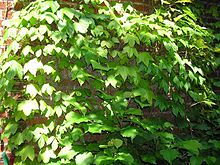RE: Boston Ivy - a green blanket for your walls.
Other Name
Wall ivy
Sun Requirements
full sun, part sun, part shade
Bloom Period and Seasonal Color
The blooms are insignificant. Mostly grown for bright red fall foliage color
Mature Height x Spread
up to 50 feet x 5 to 10 feet
Added Benefits
seasonal color, drought tolerant, deer resistant
This vigorous perennial vine is commonly found on the walls of brick buildings through out New England. The “Ivy League” refers to the Boston ivy vines often found on buildings at Harvard, Yale and Dartmouth colleges. The vines can eventually cover walls adhering to wood, wire, masonry and stone with their sucker disc or holdfasts. They don’t need any other support. The green vines produce insignificant flowers in early summer followed by black berries that birds enjoy. However, it’s the fall color that is most important. The leaves turn a red, orange, purple, or yellow color brightening up entire buildings with an autumn show. This deciduous vine can also be used as a ground cover to provide erosion control on slopes.
When, Where and How to Plant
Boston ivy is hardy through our region. Plant vines purchased from a local garden center from spring to early fall in a part sun location for the best fall color. Boston ivy grows best on well-drained, loamy soils. In warmer areas, to prevent leaf scorch plant on an East-facing wall. Space plants 5 to 10 feet apart.
Growing Tips
Boston ivy should be well watered when planted, but is drought tolerant once established. Mulch to conserve soil moisture and prevent weed growth. Boston ivy doesn’t need additional fertilization.
Regional Advice and Care
Control the vine’s growth by pruning in spring to reduce its size. Prune to keep the ivy from clogging roof gutters and getting under and lifting up roof shingles. Boston ivy can become invasive, so dig out any self-sown vines or vines that have rooted on the ground along the stems. Powdery mildew and leaf spot may form during wet summers, but can be controlled by cleaning up leaves well in fall and spraying with Serenade organic fungicide. Scale insects are sometimes a problem and can be controlled with horticultural oil sprays.
Companion Planting and Design
Make sure if planting Boston ivy on a wall you are sure you want it as a permanent fixture. Once established and clinging to the wall, it is difficult to remove. Also, it’s best to grow it up stonewall, chain link fence or masonry wall. Wooded walls will be hard to paint and may develop mold and rot due to the foliage of Boston ivy holding moisture against the wood. Boston ivy is salt spray tolerant so a good choice for homes along the coast. Boston ivy can also be used to creep along a bank or waste area to provide some erosion cover and color.
Try These
‘Veithchii’ has small purplish leaves with deep serrations. ‘Purpurea’ has reddish-purple leaves that turn bright red in fall. ‘Fenway Park’ is named after the famous baseball park in Boston close to where it was discovered. It features yellow leaves that turn green then a combination of red, orange, and yellow fall leaves.
